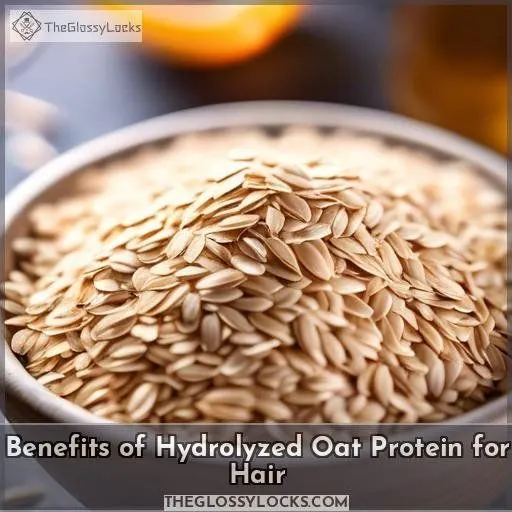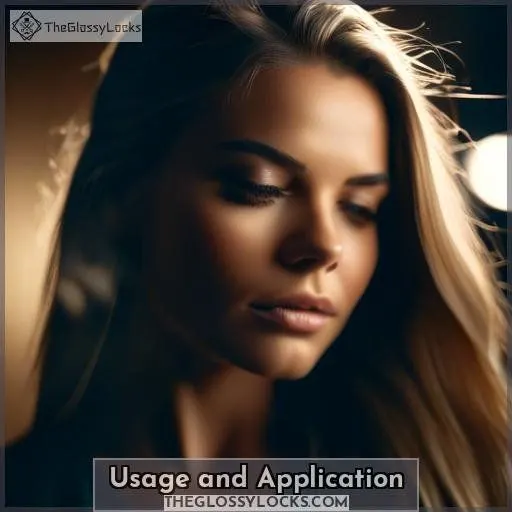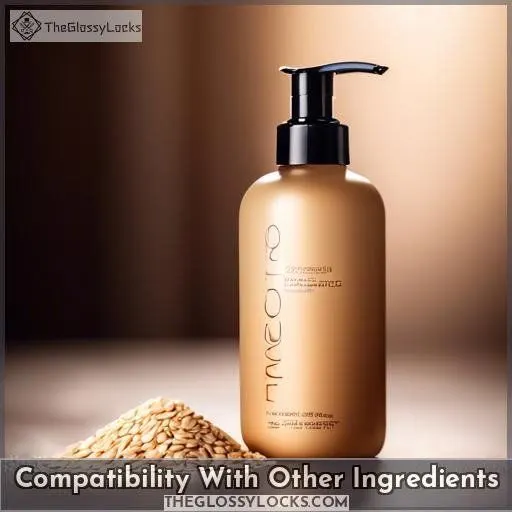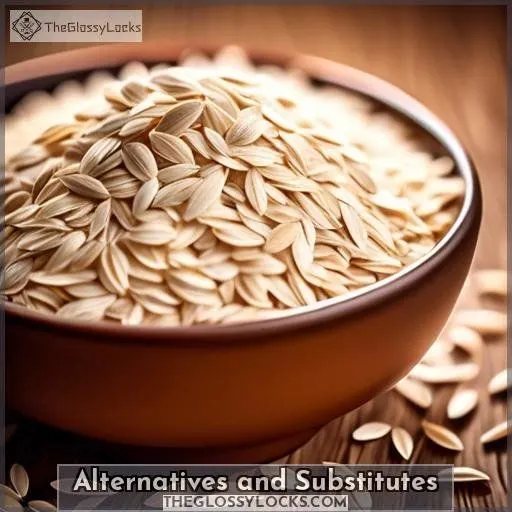This site is supported by our readers. We may earn a commission, at no cost to you, if you purchase through links.
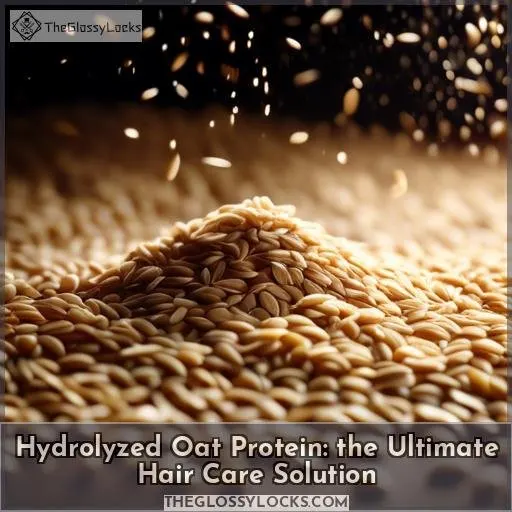
Hydrolyzed oat protein is a low molecular weight protein that can penetrate the hair, reducing breakage and damage, improving tensile strength, and protecting hair from harsh chemicals and the sun. It is suitable for all hair types and can be used in various hair care products. The recommended usage rate is 1-5%, and it is water-soluble and heat stable.
If you’re looking for a versatile hair care solution, hydrolyzed oat protein might be the answer.
Table Of Contents
- Key Takeaways
- Benefits of Hydrolyzed Oat Protein for Hair
- Usage and Application
- Compatibility With Other Ingredients
- Safety and Allergy Considerations
- Alternatives and Substitutes
- Frequently Asked Questions (FAQs)
- What is the molecular weight of hydrolyzed oat protein?
- How does hydrolyzed oat protein help retain moisture in the hair?
- Can hydrolyzed oat protein be used in shampoo formulas?
- What are the recommended usage levels for hydrolyzed oat protein in hair care products?
- Is hydrolyzed oat protein suitable for all hair types?
- Conclusion
Key Takeaways
- Hydrolyzed oat protein is a low molecular weight protein that can penetrate the hair, reducing breakage and damage, improving tensile strength, and protecting hair from harsh chemicals and the sun.
- It is suitable for all hair types and can be used in various hair care products, including shampoo, conditioner, hair masks, leave-in treatments, and styling products.
- The recommended usage rate is 1-5%, and it is water-soluble and heat stable.
- Hydrolyzed oat protein offers a range of benefits for hair, from moisturizing and hydrating to improving texture and manageability, enhancing shine, body, and protecting hair from damage.
Benefits of Hydrolyzed Oat Protein for Hair
Hydrolyzed oat protein offers a powerhouse of benefits for your hair, from moisturizing and hydrating to improving texture and manageability. It enhances shine, body, and protects against damage, making it suitable for all hair types.
Moisturizing and Hydrating Properties
Hydrolyzed oat protein is a game-changer in hair care, offering a range of benefits for your locks. It’s known for its moisturizing and hydrating properties, which can help combat dryness and add softness to your hair.
With a recommended usage rate of 1-5%, it’s compatible with a variety of ingredients and is suitable for all hair types. Allergy concerns and gluten content are minimal, as the protein is derived from oats and undergoes a proprietary hydrolysis process.
Safety assurance is high, as it meets international gluten-free standards and complies with various regulations.
Improves Hair Texture and Manageability
Hydrolyzed oat protein is a game-changer for hair care. By undergoing protein extraction, oats cultivated from fields provide a vegan source for cosmetics. This protein, with an average molecular weight of 1760 Daltons, improves hair texture and manageability.
It forms a coating on the hair cuticle, aiding in moisture retention and reducing hair porosity. By adding hydrolyzed oat protein to your hair care routine, you’ll experience improved texture and manageability, making your hair more responsive to styling.
Enhances Shine and Body
Hydrolyzed oat protein not merely enhances hair texture and manageability, but also heightens shine and body. This soluble form of whole oat protein creates a light, shiny film that dries nearly tack-free, leaving your hair with a soft, velvety feel.
By adding volume and improving elasticity, hydrolyzed oat protein guarantees your hair appears and feels its best. With a pH range of 4-6, it’s ideal for all hair types, and its water-soluble nature makes it convenient to incorporate into your chosen hair care products.
Protects Hair From Damage
Hydrolyzed oat protein is a game-changer for damaged hair, offering a range of benefits that go beyond just moisturization. This protein repair agent helps retain moisture in the hair, reducing frizz and enhancing shine.
It also strengthens hair strands, filling in gaps in the cuticle and protecting them from further damage. By incorporating hydrolyzed oat protein into your haircare products, you’re not just adding moisture, but also fortifying your hair for a healthier, more resilient look.
Suitable for All Hair Types
After safeguarding your locks from damage, let’s delve into how hydrolyzed oat protein is a game-changer for every hair type. Its versatility shines, offering unmatched hair moisturizing perks across the board. Whether you’re battling fine, limp hair or seeking a boost in your shampoo, hydrolyzed oats cater to all, infusing life and luster.
It’s the oat protein usage that truly brings your hair’s potential to the forefront.
Usage and Application
To incorporate hydrolyzed oat protein into your hair care routine, you can add it to various products such as shampoo, conditioner, or hair masks. It can also be used in leave-in treatments or styling products. The recommended usage rate is between 1-5%.
To use it in shampoo, conditioner, or hair masks, you can add it to the water phase of the recipe. If you’re using it in leave-in treatments or styling products, you can add it to the cool down phase, although the exact reason for this isn’t entirely clear.
It’s important to remember that hydrolyzed oat protein is water-soluble and heat stable, so it can be used in both hot and cold processed products.
Add to Shampoo, Conditioner, or Hair Masks
To integrate hydrolyzed oat protein into your hair care regimen, you can include it in your shampoo, conditioner, or hair masks. This will furnish your hair with the hydrating and moisturizing benefits it requires for ideal health. If you’re contending with dandruff, this protein can aid in controlling it by upholding a balanced scalp. It’s also appropriate for all hair types, encompassing those with color-treated hair.
If you’re concerned about wheat allergies, hydrolyzed silk or wheat proteins can be used as alternatives. Just remember to incorporate it into the water phase of your recipe, regardless of whether you’re employing hot or cold processing.
Can Be Used in Leave-in Treatments or Styling Products
Hydrolyzed Oat Protein is a versatile ingredient that can be used in various hair care products, including leave-in treatments and styling products. Here are three ways it can enhance your hair care routine:
- Detangling benefits: Hydrolyzed Oat Protein helps to soften and smooth the hair, making it easier to detangle. It forms a coating on the outside layers of hair strands, preventing water loss and reducing breakage.
- Frizz reduction: By adding moisture to the hair, Hydrolyzed Oat Protein helps to reduce frizz and improve overall hair manageability.
- Volumizing effects: Hydrolyzed Oat Protein can also provide volume and body to your hair. It forms a light, shiny film that dries with almost no tack, giving your hair a fuller appearance.
Recommended Usage Rate: 1-5%
When it comes to incorporating hydrolyzed oat protein into your hair care routine, it’s imperative to be aware of the suggested usage rate. This liquid cosmetic ingredient can be employed in a diverse array of products, ranging from shampoo and conditioner to hair masks and styling products.
The suggested usage rate is between 1-5%, but this can fluctuate depending on the product formulation, skin type compatibility, and hair porosity. For DIY hair recipes, you can experiment with different usage rates to determine what’s optimal for your hair.
Always adhere to the manufacturer’s instructions and consider any potential allergies, such as wheat allergy, when utilizing hydrolyzed oat protein.
Compatibility With Other Ingredients
Now that you’re informed on how to incorporate hydrolyzed oat protein into your hair care regimen, let’s explore its compatibility with other ingredients. This remarkable ingredient harmonizes well with most hair care concoctions, from shampoos to leave-in treatments, rendering it a versatile choice for any hair type.
Particularly advantageous for damaged hair, it can be a transformative element in the concluding phase of your DIY projects. Simply monitor its storage duration and be cognizant of gluten intolerance when formulating your next hair potion.
Safety and Allergy Considerations
When using hydrolyzed oat protein for hair care, it’s essential to reflect on safety and allergy concerns. While the protein is generally safe for cosmetic use, it may contain traces of gluten due to the proprietary hydrolysis process. The manufacturer has tested several lots and all contained less than 20ppm gluten, which is recognized by the FDA and Health Canada as a gluten-free threshold limit.
However, those with wheat allergies may wish to avoid hydrolyzed oat protein due to cross-contamination concerns. Additionally, it’s imperative to guarantee that the hydrolyzed oat protein is properly neutralized to eliminate any unpleasant odors and to prevent it from sinking to the bottom in shampoo formulations.
Allergy Concerns
Hydrolyzed oat protein is generally safe for those with wheat allergies or gluten intolerance, as it’s made from proprietary hydrolysis of oats and has been tested to contain less than 20ppm gluten. However, those with cross-contamination worries may wish to look into safe alternatives such as hydrolyzed silk, baobab, quinoa, rice, or wheat proteins.
It’s essential to guarantee ingredient compatibility and consult with a healthcare professional if any concerns arise.
Gluten Content
With regard to gluten content, hydrolyzed oat protein provides a safe option for individuals with gluten sensitivities. The manufacturer asserts that the product is gluten-free, although traces of gluten may persist as a result of the proprietary hydrolysis process.
Analyzed batches contained less than 20 ppm gluten, falling below the FDA and Health Canada gluten threshold. Furthermore, the product conforms to international gluten-free standards, such as those established by the Codex Alimentarius.
Beta-glucan, an advantageous component of oats, is also present in gluten-free certified oats, rendering hydrolyzed oat protein a valuable ingredient for individuals managing celiac disease.
Safety Assurance
Safety is paramount in hair care products, and hydrolyzed oat protein provides several safeguards. Its gluten-free nature makes it appropriate for individuals with wheat sensitivities or celiac disease. Moreover, it has undergone testing to guarantee its gluten content is below 20ppm, minimizing the potential for cross-contamination. Additionally, it adheres to global gluten-free standards, offering reassurance to consumers.
Finally, there’s no evidence suggesting it poses risks of cancer, birth defects, or reproductive impairments, ensuring its safety for all hair types.
Alternatives and Substitutes
Exploring the realm of hair care with a wheat allergy or gluten concerns can seem like searching for a needle in a haystack. But fear not! There are ample alternatives and substitutes that won’t leave you scratching your head (or scalp).
- Rice Protein: A lightweight champion for strength and shine.
- Quinoa Protein: Packs a punch with essential amino acids for hair repair.
- Baobab Protein: Offers a hydration heavyweight for dry, thirsty strands.
- Silk Protein: For that slip-‘n-slide smoothness without the stickiness.
These options guarantee your hair care routine is both safe and effective, letting you control your tresses without compromise.
Frequently Asked Questions (FAQs)
What is the molecular weight of hydrolyzed oat protein?
The molecular weight of hydrolyzed oat protein is approximately 1760 Daltons.
How does hydrolyzed oat protein help retain moisture in the hair?
Hydrolyzed oat protein acts like a thirst-quenching oasis for your hair, coating each strand to lock in moisture, leaving your locks lush and hydrated even when the humidity hits rock bottom.
Can hydrolyzed oat protein be used in shampoo formulas?
Yes, hydrolyzed oat protein can be used in shampoo formulas. It can be added to the water phase of the formula and is recommended for use at levels of 1-5%. Hydrolyzed oat protein is known for its hydrating properties, which can help improve the softness and shine of hair. It’s also gluten-free, making it suitable for those with gluten sensitivities.
What are the recommended usage levels for hydrolyzed oat protein in hair care products?
To use hydrolyzed oat protein in hair care products, the recommended usage levels are between 1-5%.
Is hydrolyzed oat protein suitable for all hair types?
Hydrolyzed oat protein is suitable for all hair types, as it’s a versatile ingredient that can improve the moisturizing and hydrating properties of hair care products. It’s a low molecular weight protein with a suggested usage rate of 1-5%, making it water-soluble and suitable for various hair care applications.
The protein helps to reduce hair breakage and damage, improve tensile strength, and protect hair from harsh chemicals and sun damage. It also forms a coating on the outside layers of hair strands, which can make hair feel and look thicker or volumized.
Conclusion
Just as a gardener nurtures plants to flourish, hydrolyzed oat protein offers the same care for your hair. It’s a powerhouse ingredient that moisturizes, strengthens, and shields your locks from damage, making it an essential addition to your hair care regimen.
Whether you’re mixing it into your favorite products or seeking out formulations that feature it, this versatile protein supports hair health for all types. Embrace hydrolyzed oat protein for hair that’s as resilient as it’s radiant.

